I'm totally lost with the behavior of this simple schematics. issue http://img72.imageshack.us/img72/9421/issueh.png
Once the charging process starts, Arduino's voltage reading becomes very different (should I say wrong) from the one voltmeter shows, as if there was some invisible 10 Ohm resistor in place of the switch, resulting in huge voltage drop due to some 0.5 A current. How can Atmega's A1 & A2, both being connected to the same wire, indicate different voltages?
Are here some internal Atmega's clamping diodes kicking-in or else? As for the internal resistance of the batteries, I presume voltmeter correctly indicates 0.2V drop.
ps: yes, I know, the schematics is incomplete. It has no protection resistors on Analogue input pins, also, the high-side MOSFET should replace the switch.
 Batteries - NiCd, 1.2V, 2500Ah
Batteries - NiCd, 1.2V, 2500Ah